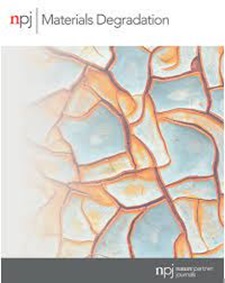Localized corrosion in selective laser melted SS316L in CO2 and H2S brines at elevated temperatures
IF 7.6
2区 材料科学
Q1 MATERIALS SCIENCE, MULTIDISCIPLINARY
引用次数: 0
Abstract
In this work, the passivation and localized corrosion of selective laser melted (SLM) stainless steel 316 L when exposed to high pressures of CO2 with the presence of H2S and Cl− at 25 °C and 125 °C were studied. Depletion of Cr/Mo was observed at the cell interiors and melt-pool boundaries (MPBs) compared to the cell boundaries. Volta potential differences obtained from scanning Kelvin probe force microscopy (SKPFM) showed that the MPBs were 8–20 mV lower than the matrix, while the cell interiors were 20–50 mV lower than the cell boundaries. Electrochemical impedance spectroscopy (EIS) and Mott–Schottky tests indicated a more defective passive film at 125 °C, and X-ray photoelectron spectroscopy (XPS) confirmed the formation of a less protective film with an increased S/O ratio at 125 °C than 25 °C. Initiation of localized corrosion was observed at the MPBs and pits formed after a week of immersion were wider by an order of magnitude at 125 °C than 25 °C, with evidence of cell-interior dissolution. While passivity was observed even at elevated temperatures, local chemical heterogeneities compromised the stability of the film and contributed to localized corrosion in SLM SS316L.

选择性激光熔化 SS316L 在 CO2 和 H2S 盐水中的局部腐蚀,温度升高
在这项工作中,研究了选择性激光熔化(SLM)不锈钢 316 L 在 25 °C 和 125 °C 下暴露于存在 H2S 和 Cl- 的高压 CO2 时的钝化和局部腐蚀情况。与晶胞边界相比,在晶胞内部和熔池边界 (MPB) 观察到了铬/钼的损耗。从扫描开尔文探针力显微镜(SKPFM)获得的伏特电位差显示,MPB 比基质低 8-20 mV,而电池内部比电池边界低 20-50 mV。电化学阻抗谱(EIS)和莫特-肖特基测试表明,125 °C时被动膜的缺陷更大,X射线光电子能谱(XPS)证实,125 °C时形成的保护膜比25 °C时的S/O比更小。在 MPB 上观察到局部腐蚀的开始,浸泡一周后形成的凹坑在 125 °C时比 25 °C时宽一个数量级,并有细胞内部溶解的证据。虽然即使在高温下也能观察到钝化现象,但局部化学异质性损害了薄膜的稳定性,并导致了 SLM SS316L 的局部腐蚀。
本文章由计算机程序翻译,如有差异,请以英文原文为准。
求助全文
约1分钟内获得全文
求助全文
来源期刊

npj Materials Degradation
MATERIALS SCIENCE, MULTIDISCIPLINARY-
CiteScore
7.80
自引率
7.80%
发文量
86
审稿时长
6 weeks
期刊介绍:
npj Materials Degradation considers basic and applied research that explores all aspects of the degradation of metallic and non-metallic materials. The journal broadly defines ‘materials degradation’ as a reduction in the ability of a material to perform its task in-service as a result of environmental exposure.
The journal covers a broad range of topics including but not limited to:
-Degradation of metals, glasses, minerals, polymers, ceramics, cements and composites in natural and engineered environments, as a result of various stimuli
-Computational and experimental studies of degradation mechanisms and kinetics
-Characterization of degradation by traditional and emerging techniques
-New approaches and technologies for enhancing resistance to degradation
-Inspection and monitoring techniques for materials in-service, such as sensing technologies
 求助内容:
求助内容: 应助结果提醒方式:
应助结果提醒方式:


